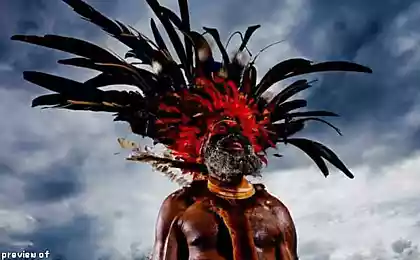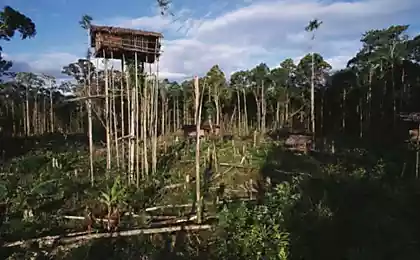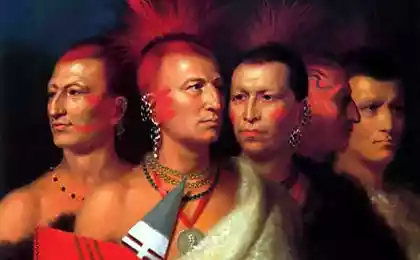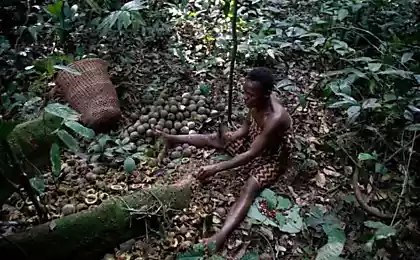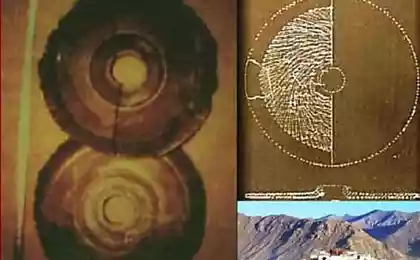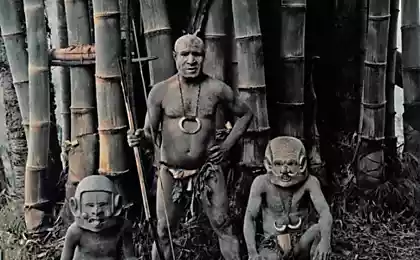973
Hadza - a small African tribe
Hadza - the indigenous people of northern Tanzania. Living in the provinces of Arusha, Singida and Shinyanga near Lake Eyasi. They talk on the isolated eponymous language. Traditional clothing for women - leather apron, men - an apron and a belt of modesty. Typically, barefoot, in the transitions of thorns worn sandals. Families of Hadza form small, nomadic groups together. Typically, the transition to a new location takes place once every two weeks. The composition of such groups is not constant, at the request of their members, they may be combined or separated. The territories occupied by communities or "resident groups" have no clear boundaries, virtually every Hadza may live, hunt and collect food wherever He wills. In the dry season Hadza into groups of 100-200 people, and in the rainy season - re-live in separate communities.
19 ph via Bigpicture
1. thrower spaces and dry vegetation allow sharp eyes to see prey for many kilometers ahead. With the wind bend the tree man named Mahiya looks through rugged territory habitat Hadza people. (Martin Schoeller)
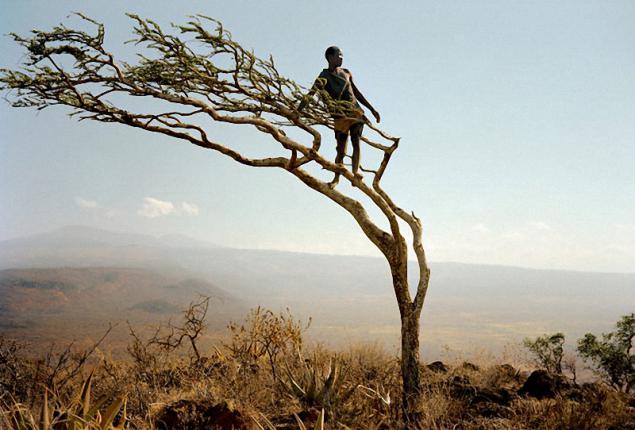
2. Like its ancestors, the young Nij grow in the territory around the lake Eyasi in northern Tanzania. Unless, of course, the pressure of the outside world does not break the freedom of his people. (Martin Schoeller)

3. Everyone takes something from the place of hunting in their camp. For Kapali is the head kudu. His group of friends and relatives, will revel until he eat all the meat. (Martin Schoeller)
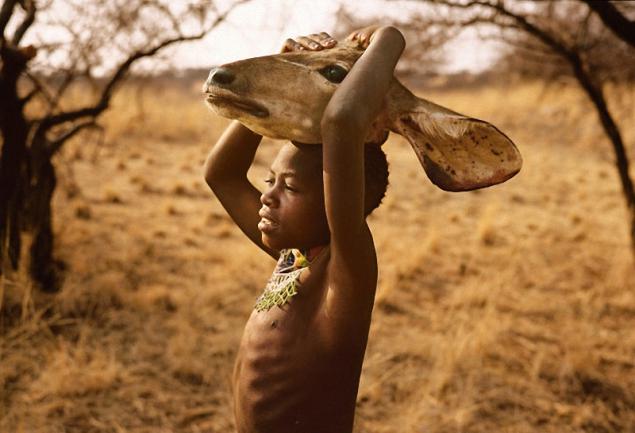
4. Onvas (rear left) laughs with men and boys from their camp until the juice is boiled in a pot for the production of rose thorns to poison their arrows. (Martin Schoeller)
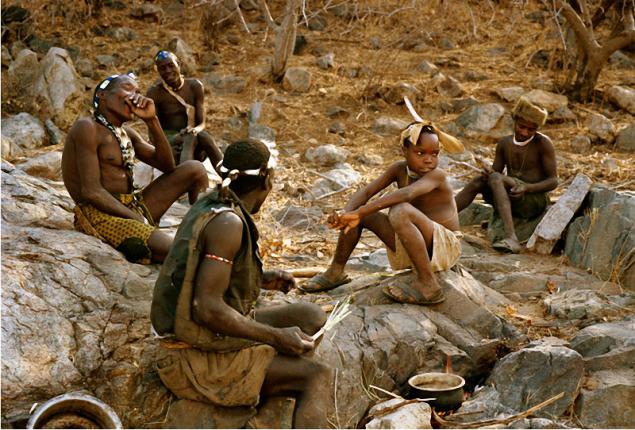
5. As soon hear a rustling in the bushes, a man grabs his bow and crouched silently goes to his prey. While large prey is much more attractive, Hadza hunters can be satisfied with less big game such as antelope dik-dik, birds or calves galago. (Martin Schoeller)

6. His time has passed hunter, but as a storyteller, he is just beginning. Onvas - the main figure for one of the many groups of people Hadza, who still lead the old hunting life. (Martin Schoeller)
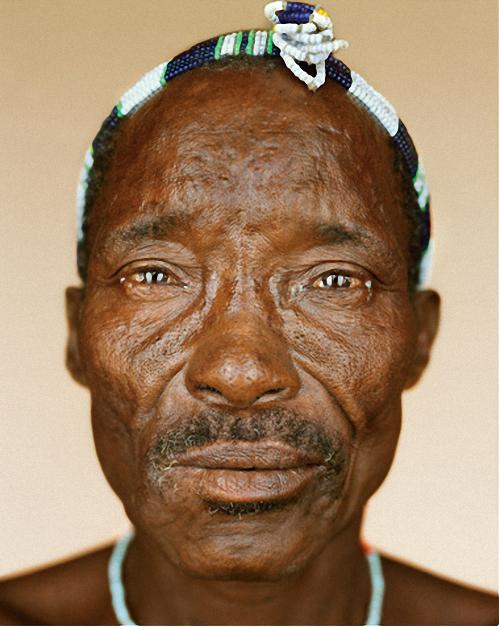
7. The Group of hunters stalking a wounded warthog on the trail of blood, using skills passed down from generation to generation. In this photo taken near the edge of the Serengeti plains, Hadza hunters stumbled upon as larger prey - a giraffe. A good shooter Garah (right) get the bulk of the meat. (Martin Schoeller)
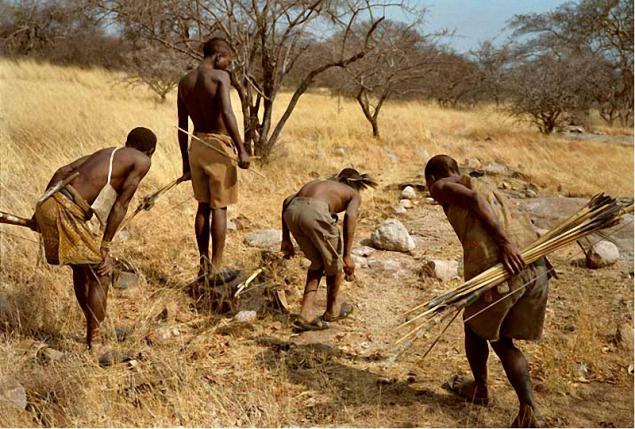
8. While the men hunt, the women split the baobab fruit to give a gum which is inside the fruit. The diet of the Hadza tribe fruits and fruit extracted by women, it is more important meat. Several hundred groups from all Hadza population rely entirely on food grown by themselves, despite the proximity of the farm communities. (Martin Schoeller)
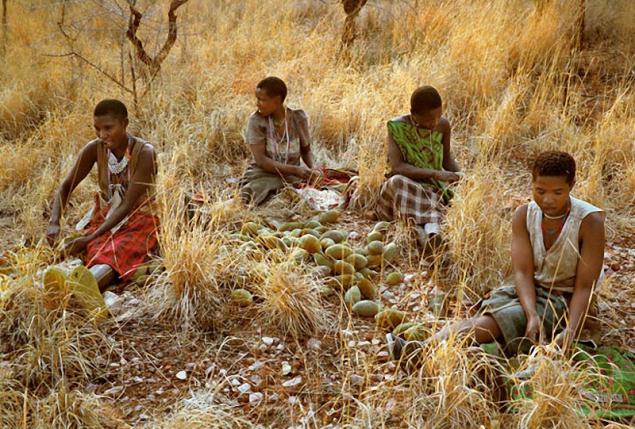
9. Surrounded by their few belongings, Tembo is sitting at the campfire ashes in the "residential area" camp under the open sky. Most of the Hadza are sleeping outdoors in the dry season, because, as they say, the wind drives away mosquitoes. (Martin Schoeller)

10. Women Hadza people, such as myself, - the independent and free, they are free to marry and divorce. The scars on her cheeks - since childhood. Because they have been taught to restrain her tears, because in contact with them on the scars, they started pinching. (Martin Schoeller)
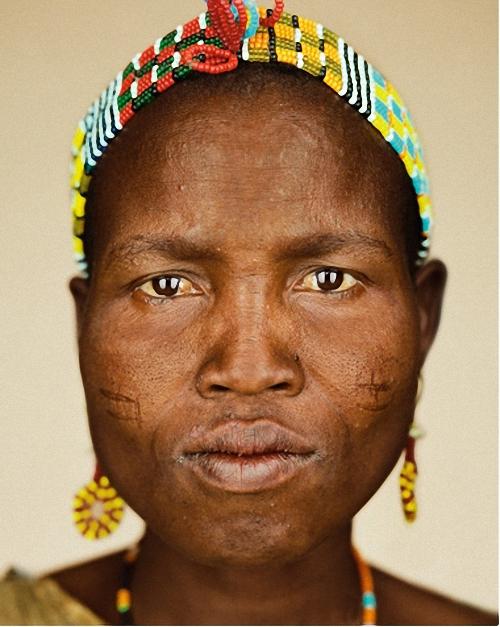
11. As they get older, Nkole will take on even more adult obligations. (Martin Schoeller)
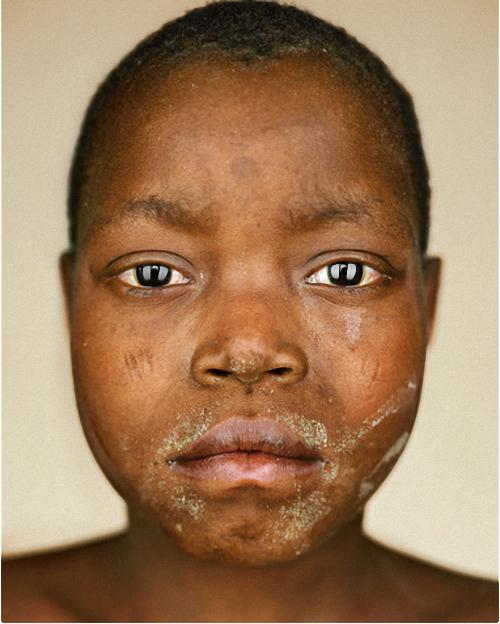
12. Sangu - Nkole sister. (Martin Schoeller)

13. The wildlife in the bush can be traced on the face of Mocoa - an experienced hunter. Perhaps the hair style genette need to impress, and it can spot a fad - Hadza people love to show off. (Martin Schoeller)

14. Chausiku and Sisiem (with a baby on her back), gathering berries, known Hadzane language Hadza how ngvilabi. Research anthropologist Frank Marlowe found that the berries are 17% of food in the camps Hadza people. Calories they are almost equal to meat. (Martin Schoeller)

15. The men undress dwarf antelopes di wild next to the hut in the traditional camp. (Martin Schoeller)

16 Boka (right) dances until Lavi (left) seems to be fixed. Dancing - a favorite form of entertainment in the Hadza communities for both children and adults. (Martin Schoeller)
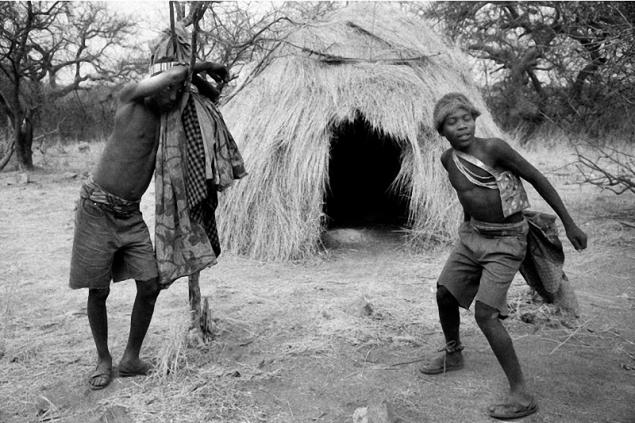
17. Hunters baboons are prey to the camp at sunrise. Arrows tipped with poisonous wild roses help catch prey. Tissue around the wound is cut in order to avoid a dangerous poison. (Martin Schoeller)

18. When the camp appears next carcass, and you can indulge in dancing, but dancing Hadza and night as a ritual, and in the afternoon - for fun. (Martin Schoeller)
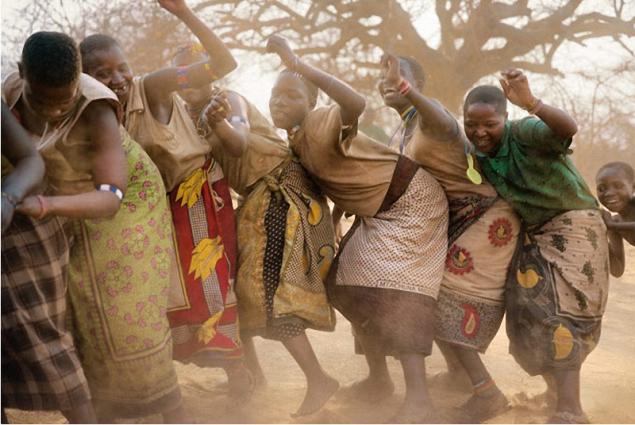
19. Holo - daughter Onvy - raises her five children in a close relationship with nature that supports them. Hadza people are not interested in modern innovations, they continue to live according to their traditions and rules. (Martin Schoeller)
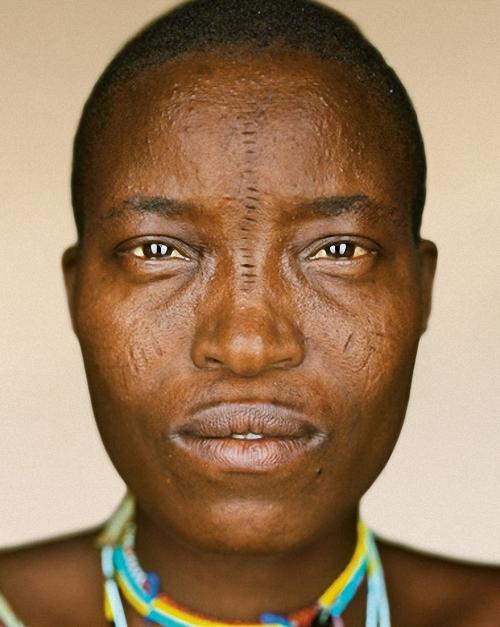
Source:
19 ph via Bigpicture
1. thrower spaces and dry vegetation allow sharp eyes to see prey for many kilometers ahead. With the wind bend the tree man named Mahiya looks through rugged territory habitat Hadza people. (Martin Schoeller)

2. Like its ancestors, the young Nij grow in the territory around the lake Eyasi in northern Tanzania. Unless, of course, the pressure of the outside world does not break the freedom of his people. (Martin Schoeller)

3. Everyone takes something from the place of hunting in their camp. For Kapali is the head kudu. His group of friends and relatives, will revel until he eat all the meat. (Martin Schoeller)

4. Onvas (rear left) laughs with men and boys from their camp until the juice is boiled in a pot for the production of rose thorns to poison their arrows. (Martin Schoeller)

5. As soon hear a rustling in the bushes, a man grabs his bow and crouched silently goes to his prey. While large prey is much more attractive, Hadza hunters can be satisfied with less big game such as antelope dik-dik, birds or calves galago. (Martin Schoeller)

6. His time has passed hunter, but as a storyteller, he is just beginning. Onvas - the main figure for one of the many groups of people Hadza, who still lead the old hunting life. (Martin Schoeller)

7. The Group of hunters stalking a wounded warthog on the trail of blood, using skills passed down from generation to generation. In this photo taken near the edge of the Serengeti plains, Hadza hunters stumbled upon as larger prey - a giraffe. A good shooter Garah (right) get the bulk of the meat. (Martin Schoeller)

8. While the men hunt, the women split the baobab fruit to give a gum which is inside the fruit. The diet of the Hadza tribe fruits and fruit extracted by women, it is more important meat. Several hundred groups from all Hadza population rely entirely on food grown by themselves, despite the proximity of the farm communities. (Martin Schoeller)

9. Surrounded by their few belongings, Tembo is sitting at the campfire ashes in the "residential area" camp under the open sky. Most of the Hadza are sleeping outdoors in the dry season, because, as they say, the wind drives away mosquitoes. (Martin Schoeller)

10. Women Hadza people, such as myself, - the independent and free, they are free to marry and divorce. The scars on her cheeks - since childhood. Because they have been taught to restrain her tears, because in contact with them on the scars, they started pinching. (Martin Schoeller)

11. As they get older, Nkole will take on even more adult obligations. (Martin Schoeller)

12. Sangu - Nkole sister. (Martin Schoeller)

13. The wildlife in the bush can be traced on the face of Mocoa - an experienced hunter. Perhaps the hair style genette need to impress, and it can spot a fad - Hadza people love to show off. (Martin Schoeller)

14. Chausiku and Sisiem (with a baby on her back), gathering berries, known Hadzane language Hadza how ngvilabi. Research anthropologist Frank Marlowe found that the berries are 17% of food in the camps Hadza people. Calories they are almost equal to meat. (Martin Schoeller)

15. The men undress dwarf antelopes di wild next to the hut in the traditional camp. (Martin Schoeller)

16 Boka (right) dances until Lavi (left) seems to be fixed. Dancing - a favorite form of entertainment in the Hadza communities for both children and adults. (Martin Schoeller)

17. Hunters baboons are prey to the camp at sunrise. Arrows tipped with poisonous wild roses help catch prey. Tissue around the wound is cut in order to avoid a dangerous poison. (Martin Schoeller)

18. When the camp appears next carcass, and you can indulge in dancing, but dancing Hadza and night as a ritual, and in the afternoon - for fun. (Martin Schoeller)

19. Holo - daughter Onvy - raises her five children in a close relationship with nature that supports them. Hadza people are not interested in modern innovations, they continue to live according to their traditions and rules. (Martin Schoeller)

Source:





